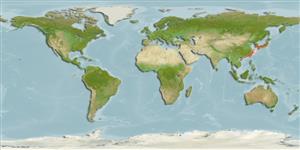Klassifizierung / Names
Namen | Synonyme | Catalog of Fishes(Gattung, Arten) | ITIS | CoL | WoRMS | Cloffa
Elasmobranchii (Haie und Rochen) (sharks and rays) >
Myliobatiformes (Stingrays) >
Dasyatidae (Stingrays) > Dasyatinae
Etymology: Telatrygon: Name from Latin 'telum' for javelin, spear, arrow, dart and Greek 'trygon' for stingray; referring to the long, narrowly pointed snout possessed by all members of the genus.; acutirostra: Name from Latin 'acuti' for acute and 'rostra' for snout (Ref. 35022).
Environment: milieu / climate zone / depth range / distribution range
Ökologie
seewasser demersal; tiefenbereich 53 - 142 m (Ref. 58018). Subtropical
Northwest Pacific: off the coast of southern Japan and the East China Sea (Ref. 7445). Range extension reported from the Gulf of Guayaquil, Ecuador (Ref. 74597).
Size / Gewicht / Alter
Maturity: Lm ? range ? - ? cm
Max length : 10.6 cm WD Männchen/unbestimmt; (Ref. 35022)
Ovoviviparous (Ref. 50449).
Life cycle and mating behavior
Geschlechtsreife | Fortpflanzung | Ablaichen | Eier | Fecundity | Larven
Exhibit ovoviparity (aplacental viviparity), with embryos feeding initially on yolk, then receiving additional nourishment from the mother by indirect absorption of uterine fluid enriched with mucus, fat or protein through specialised structures (Ref. 50449). Distinct pairing with embrace (Ref. 205).
Nishida, K. and K. Nakaya, 1990. Taxonomy of the genus Dasyatis (Elasmobranchia, Dasyatidae) from the North Pacific. In: Pratt Jr., H. L., S. H. Gruber and T. Taniuchi (eds.): Elasmobranchs as living resources: advances in the biology, ecology, systematics, and the status of the fisheries. NOAA (National Oceanic and Atmospheric Administration) Tech. Rept. NMFS 90:327-346. (Ref. 7445)
IUCN Rote Liste Status (Ref. 130435)
Bedrohung für Menschen
Harmless
Nutzung durch Menschen
Mehr Information
Alter/Größe
Wachstum
Länge-Gewicht
Länge-Länge
Längenhäufigkeiten
Morphometrie
Morphologie
Larven
Larven Pop.Dyn.
Rekrutierung
Dichte
BRUVS
ReferenzenAquakulturAquakultur ProfilZuchtlinienGenetikElectrophoresesVererbbarkeitKrankheitenVerarbeitungNutrientsMass conversion
PartnerBilderStamps, Coins Misc.LauteCiguateraGeschwindigkeitSchwimmstilKiemenoberflächeOtolithsGehirngrößeSehfähigkeit
Tools
Zusatzinformationen
Download XML
Internet Quellen
Estimates based on models
Preferred temperature (Ref.
123201): 14.5 - 23.2, mean 17.9 °C (based on 60 cells).
Phylogenetic diversity index (Ref.
82804): PD
50 = 0.6250 [Uniqueness, from 0.5 = low to 2.0 = high].
Bayesian length-weight: a=0.00646 (0.00265 - 0.01571), b=3.06 (2.86 - 3.26), in cm total length, based on LWR estimates for this (Sub)family-body shape (Ref.
93245).
Trophic level (Ref.
69278): 3.9 ±0.6 se; based on size and trophs of closest relatives
Widerstandsfähigkeit (Ref.
120179): niedrig, Verdopplung der Population dauert 4,5 - 14 Jahre. (Assuming fecundity<100).
Fishing Vulnerability (Ref.
59153): Very high vulnerability (90 of 100).
